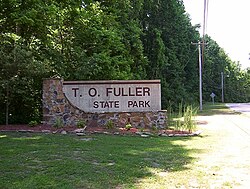T. O. Fuller State Park
| T.O. Fuller State Park | |
|---|---|
 T.O. Fuller State Park Memphis TN | |
 | |
| Type | Tennessee State Park |
| Location | Memphis, Shelby County, Tennessee |
| Coordinates | 35°03′35″N 90°06′51″W / 35.0597°N 90.1142°W |
| Area | 1,138 acres (461 ha) |
| Operated by | TDEC |
| Website | T.O. Fuller State Park |
T.O. Fuller State Park is a state park in the city of Memphis, Tennessee, USA. It consists of 1,138 acres (461 ha) of mostly forest located in South Memphis on Mitchell Road. It is the only state park within the city limits and is suitable for wildlife.
The park is named in honor of Dr. Thomas O. Fuller, who spent his life empowering and educating African Americans.[1] The park facilities were originally built for the use of African Americans in the Great Depression by the Civilian Conservation Corps (CCC). It was the first state park in the United States east of the Mississippi River that was open to African Americans.[2]
CCC camp number 1464-SP-10, which was composed of African Americans, initiated construction of the park facilities in 1938. During excavation for a proposed swimming pool in 1940, CCC workers unearthed evidence of a prehistoric village. The site has since been developed as Chucalissa Indian Village and includes a village, preserved archeological excavations and the C.H. Nash Museum at Chucalissa.[3]
Facilities
[edit]
Amenities at T.O. Fuller State Park include sheltered picnic areas, tennis courts, swimming pool, basketball courts, softball field, six miles (10 km) of hiking trails and camping facilities.[4] The park's nature center is open in the summer and features natural history exhibits and programs.
C.H. Nash Museum at Chucalissa
[edit]During construction of T.O. Fuller State Park in 1938, the CCC discovered Native American artifacts on the site, now known as Chucalissa. The University of Tennessee initiated archaeological excavations of this Mississippian mound complex in 1940, but this work was interrupted by World War II. Excavations and other work at Chucalissa began once again in 1955. The facility is currently operated by the University of Memphis and serves as a gateway for understanding archaeology and the interpretation of Native American history.[5]
It was declared a National Historic Landmark in 1994.[6][7]
References
[edit]- ^ Carroll Van West, "Thomas Oscar Fuller.", Tennessee Encyclopedia of History and Culture.
- ^ "T.O. Fuller State Park — Tennessee State Parks". Tennessee State Parks. December 20, 2016. Archived from the original on December 20, 2016. Retrieved June 11, 2019.
- ^ Tennessee Department of Environment & Conservation pamphlet: authorization no. 327152 (July 2009)
- ^ Susanna Henighan Potter, Moon Tennessee, 2009 edition
- ^ "About Chucalissa". Accessed August 2009
- ^ Gerald P. Smith; Charles McNutt & Mark R. Barnes (January 29, 1993). "National Register of Historic Places Inventory-Nomination: Chucalissa Site / 40SY1" (PDF). National Park Service. Retrieved June 22, 2009.
{{cite journal}}: Cite journal requires|journal=(help) and Accompanying eight photos, aerial, site, and artifacts, from 1970, 1980, 1987, 1990, and undated (1.02 MB) - ^ "Chucalissa Site". National Historic Landmark summary listing. National Park Service. Archived from the original on June 6, 2008. Retrieved June 29, 2008.
External links
[edit]- State parks of Tennessee
- University of Memphis
- Nature centers in Tennessee
- Civilian Conservation Corps in Tennessee
- Parks in Memphis, Tennessee
- Protected areas of Shelby County, Tennessee
- Mounds in Tennessee
- African-American history of Tennessee
- Protected areas established in 1938
- 1938 establishments in Tennessee







